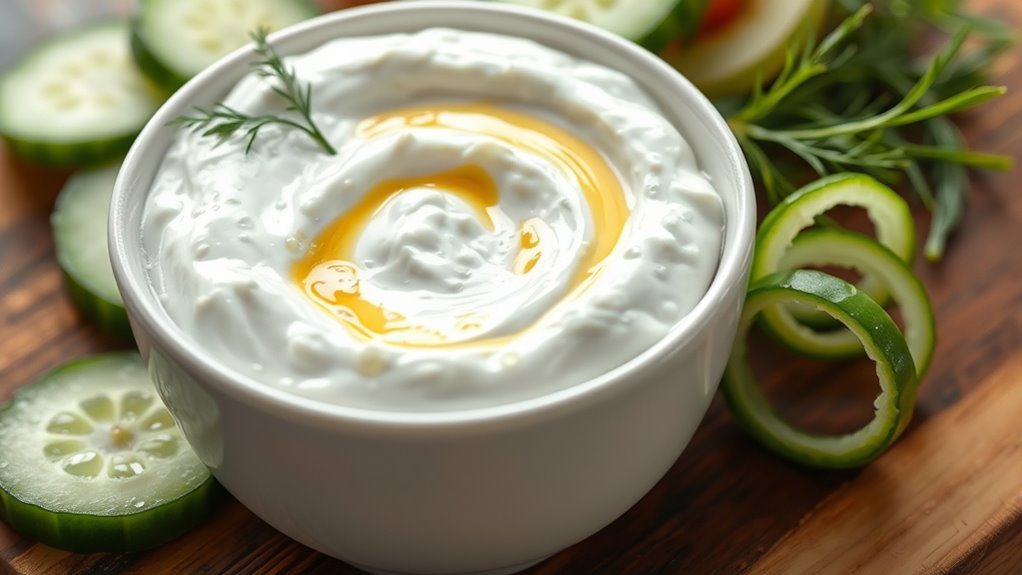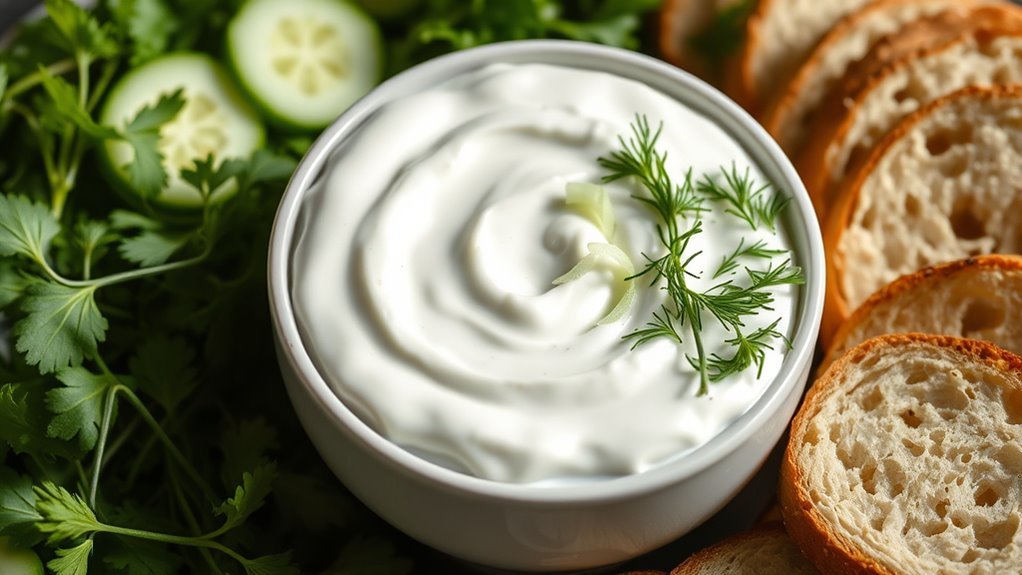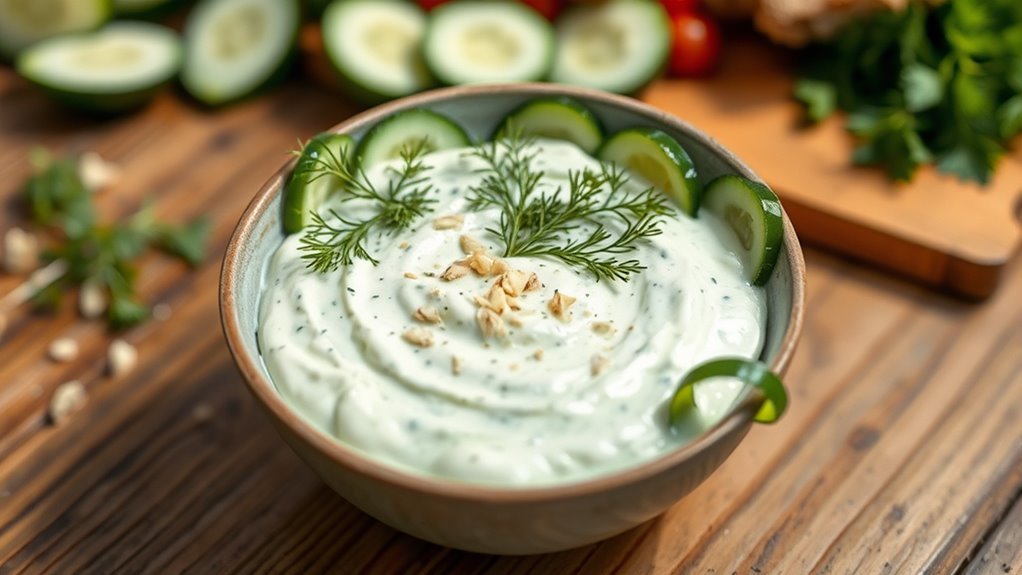Yes, tzatziki sauce is keto-friendly! It’s low in carbs, with about 1-2 grams of carbs per tablespoon, making it a perfect addition to a ketogenic diet. The primary ingredients—yogurt, cucumbers, garlic, and herbs—contribute to its low-calorie profile while offering health benefits like probiotics and antioxidants. Greek yogurt, often used in tzatziki, is also generally low in carbs. If you’re curious about how to incorporate it into your meals, there’s more to explore!
What Is Tzatziki Sauce?

Tzatziki sauce is a revitalizing condiment that hails from Greek cuisine, known for its creamy texture and vibrant flavors. Its origin story traces back to ancient Greece, where it was often enjoyed alongside grilled meats and fresh vegetables. The cultural significance of tzatziki can’t be overstated; it embodies the Mediterranean lifestyle, emphasizing fresh ingredients and communal dining. This sauce showcases the harmonious blend of yogurt, cucumbers, garlic, and herbs, making it a beloved staple in many Mediterranean households. When you enjoy tzatziki, you’re not just tasting a delicious condiment; you’re partaking in a culinary tradition that celebrates freshness and flavor. Embracing tzatziki can enhance your meals while connecting you to a rich cultural heritage.
Key Ingredients in Tzatziki

When you look at tzatziki sauce, the key ingredients play an essential role in its keto-friendliness. Cucumbers are low in carbs, making them a great option for your diet, while the yogurt can vary in fat content, affecting both texture and carb levels. Understanding these components can help you enjoy this invigorating sauce without straying from your keto goals.
Cucumber’s Low Carb Benefits
Cucumbers serve as a invigorating and low-calorie base for many dishes, including tzatziki sauce. Not only do they add a revitalizing crunch, but they also offer several cucumber benefits that align perfectly with your low carb options. Here are three key advantages:
- Low in Carbs: Cucumbers contain just about 3 grams of carbs per 100 grams, making them an excellent choice for a keto diet.
- Hydration: Composed of 95% water, cucumbers help keep you hydrated, which is essential for overall health.
- Nutrient-Rich: They are rich in vitamins K and C, contributing to your daily nutrient intake without adding excess calories.
Incorporating cucumbers into your meals not only enhances flavor but also supports your low-carb lifestyle effectively.
Yogurt Variations and Options
While many people think of tzatziki sauce primarily as a cucumber-based dip, the yogurt used in its preparation plays an essential role in defining its texture and flavor. Traditional tzatziki uses Greek yogurt, which is thick and tangy. However, if you’re looking for yogurt substitutes or dairy alternatives, there are several options to explore.
| Yogurt Option | Description |
|---|---|
| Greek Yogurt | Creamy, high-protein option |
| Coconut Yogurt | Dairy-free, slightly sweet |
| Almond Yogurt | Nutty flavor, low in carbs |
| Soy Yogurt | Plant-based, versatile |
| Cashew Yogurt | Creamy texture, rich flavor |
Experimenting with these variations can help you create a tzatziki that fits your dietary needs while still preserving that classic taste.
Nutritional Profile of Tzatziki Sauce

Tzatziki sauce is a revitalizing blend of yogurt, cucumbers, garlic, and herbs, making it a popular choice in Mediterranean cuisine. Understanding the nutritional breakdown can help you appreciate its benefits:
- Low in Calories: Typically, a serving contains about 50 calories, allowing for guilt-free enjoyment.
- Rich in Protein: The yogurt base provides a good source of protein, essential for muscle repair and growth.
- Packed with Nutrients: Cucumbers and garlic contribute vitamins and antioxidants that support overall health.
In this ingredient analysis, you’ll find that tzatziki is not only delicious but also nutrient-dense. This makes it an excellent addition to various dishes, whether you’re pursuing a keto lifestyle or just looking for a healthy dip.
Carb Content in Tzatziki
When considering a keto diet, it is crucial to pay attention to the carb content of the foods you consume, and tzatziki sauce is generally a favorable option. Its low carb count makes it a great choice for your meals.
Here’s a quick carb comparison based on typical serving sizes:
| Serving Size | Carbs (g) |
|---|---|
| 1 tbsp | 1.0 |
| 2 tbsp | 2.0 |
| 1/4 cup | 3.0 |
| 1/2 cup | 6.0 |
| 1 cup | 12.0 |
With such low carbs per serving, tzatziki can easily fit into your daily macros, giving you the freedom to enjoy this revitalizing sauce without guilt. Just remember to keep an eye on serving sizes to maximize your keto success!
Is Greek Yogurt Keto-Friendly?
When considering if Greek yogurt is keto-friendly, you’ll want to look closely at its carbohydrate content. Typically, plain Greek yogurt contains fewer carbs compared to regular yogurt, making it a more suitable option for a ketogenic diet. Additionally, it offers nutritional benefits like protein and probiotics, which can support overall health while you follow a low-carb lifestyle.
Carbohydrate Content Analysis
Although many people enjoy Greek yogurt for its creamy texture and tangy flavor, its carbohydrate content raises questions about its compatibility with a ketogenic diet. If you’re carb counting, here are three key points to evaluate:
- Carb Count: A typical serving of plain Greek yogurt contains about 6-8 grams of carbs, which can fit into your daily limit if managed carefully.
- Type Matters: Opt for full-fat varieties, as they’re lower in carbs compared to flavored or low-fat options.
- Portion Control: Keeping your serving size in check is essential for maintaining ketosis.
Ultimately, while Greek yogurt can be enjoyed on a keto diet, it’s important to monitor your intake to stay within your goals.
Nutritional Benefits Overview
While you might be concerned about the carbohydrate content of Greek yogurt on a ketogenic diet, it also offers several nutritional benefits that can support your overall health. Greek yogurt is known for its high nutrient density, providing essential vitamins and minerals. Additionally, the probiotics found in Greek yogurt can enhance your digestive health, fostering a balanced gut microbiome.
| Nutritional Component | Benefits |
|---|---|
| Protein | Supports muscle growth and repair |
| Probiotics | Aids in digestive health |
| Calcium | Strengthens bones and teeth |
Incorporating Greek yogurt into your diet can be a smart choice, allowing you to enjoy its creamy texture while reaping its health benefits, all while staying within your keto goals.
How to Make Keto-Friendly Tzatziki
To create a keto-friendly tzatziki sauce, you’ll want to focus on low-carb ingredients that maintain the dish’s classic flavor. Here’s how you can whip up a delicious version:
Create a keto-friendly tzatziki sauce by using low-carb ingredients while keeping its classic flavor intact.
- Greek Yogurt: Use full-fat Greek yogurt, which is lower in carbs and rich in healthy fats.
- Cucumber: Grate a small cucumber and squeeze out excess moisture to keep it fresh and crunchy.
- Garlic and Herbs: Incorporate minced garlic, dill, and mint for that traditional tzatziki taste while keeping carbs minimal.
These keto variations not only keep your tzatziki dips keto-friendly but also guarantee you enjoy a revitalizing flavor. With these simple ingredients, you can easily make a delightful sauce that fits perfectly into your low-carb lifestyle.
Serving Suggestions for Tzatziki on a Keto Diet
When you’re following a keto diet, tzatziki sauce can be a versatile addition to your meals, enhancing flavors and textures without adding unnecessary carbs. You can use tzatziki as a dip for raw veggies like cucumbers, bell peppers, or celery—perfect for satisfying your snack cravings. It also makes a fantastic accompaniment to grilled meats, adding moisture and zest to dishes like chicken or lamb. You might even spread it on low-carb wraps or lettuce leaves for a revitalizing twist. For gatherings, consider tzatziki pairings with low-carb dips, creating a delicious spread that keeps your carb count in check while still offering variety. Enjoy experimenting with tzatziki to elevate your keto meal experience!
Health Benefits of Tzatziki Sauce
Tzatziki sauce offers numerous health benefits that can complement your keto lifestyle. This invigorating dip isn’t just tasty; it’s also packed with nutrients that support overall well-being. Here are three notable health benefits:
- Probiotic Power: The yogurt base is rich in probiotics, which aid digestion and promote gut health.
- Immune Support: Ingredients like garlic and cucumber provide antioxidants and vitamins, boosting your immune system.
- Low-Calorie Flavor: It adds flavor without the carbs, making it a perfect addition to your meals.
Incorporating tzatziki into your diet can enhance your health while keeping your meals exciting. So, indulge in this delicious sauce guilt-free and enjoy the benefits it brings to your keto journey!
Frequently Asked Questions
Can I Substitute Any Ingredients for a Dairy-Free Tzatziki?
Yes, you can definitely substitute ingredients for a dairy-free tzatziki! Try using dairy alternatives like coconut yogurt or almond yogurt for a creamy base. For flavor variations, add fresh herbs like dill or mint, and don’t forget to include lemon juice and garlic for that classic zing. You can also experiment with cashew cream for a richer texture. With these substitutions, you’ll enjoy a delicious and satisfying dip that meets your dietary needs!
How Long Does Homemade Tzatziki Last in the Fridge?
Homemade tzatziki typically lasts about 3 to 5 days in the fridge. To maximize its shelf life, store it in an airtight container and keep it away from strong-smelling foods. It’s best to consume it fresh, but if you notice any signs of spoilage, like an off smell or separation, it’s safer to toss it. Enjoy your tzatziki within a week for the best taste and quality!
Can Tzatziki Sauce Be Frozen for Later Use?
Yes, you can freeze tzatziki sauce for later use! It’s like capturing a summer picnic in a frosty embrace. To do this, use proper freezing techniques—store it in airtight containers or freezer bags, removing as much air as possible. When you’re ready to enjoy it again, use gentle thawing methods, like placing it in the fridge overnight. Just remember, the texture might change a bit, but the flavor should still shine through!
Is Tzatziki Sauce Suitable for Paleo Diets?
Tzatziki sauce isn’t typically considered paleo due to its dairy content, but you can easily make it suitable by using dairy alternatives. Instead of yogurt, try coconut yogurt or cashew-based options, which align better with paleo ingredients. This way, you can still enjoy that creamy texture and invigorating taste without straying from your dietary goals. Just be certain to check ingredient labels to verify everything fits within your paleo lifestyle!
What Are Some Alternative Uses for Tzatziki Sauce Beyond Dipping?
You can use tzatziki sauce in several creative ways beyond dipping. Try it as a revitalizing dressing for salads or grain bowls; its creamy texture complements various ingredients. It also works great as a marinade for chicken or lamb, infusing them with flavor before grilling. Additionally, consider using it as a topping for baked potatoes or roasted vegetables, adding a zesty twist. These alternatives showcase tzatziki’s versatility in enhancing your meals.


